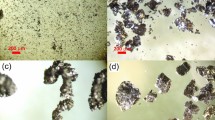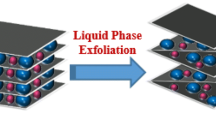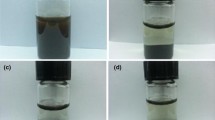Abstract
Natural flaky graphite in Shandong, China was purified by H2O2, a new patent method to produce graphite without sulfur and used as precursor to prepare exfoliated graphite through microwave irradiated expansion with some chemicals (such as hydrogen peroxide, nitric acid, and acetic acid). With the centrifugation process, graphene was synthesized by using an efficient and simple method under ultrasonic and microwave irradiation at the room temperature. Natural graphite and exfoliated graphite were characterized by X-ray diffraction and scanning electronic microscopy, and the resultant graphene was investigated and confirmed by atomic force microscopy, Raman micro-spectrometer, etc. Natural graphite in Shandong, China, consisted of mainly hexagonal (2H) and a little rhombohedral structure (3R), was beneficial for the synthesis of graphene. Graphene-like nanosheets about 1 to 3 nm, around three to five carbon layers can be synthesized efficiently by microwave and ultrasonic irradiation with natural graphite.
Similar content being viewed by others
Background
Due to the distinct properties and potential applications, graphene is very promising in various fields, such as field-effect transistors, lithium ion batteries, hydrogen storage, and molecular sensors [1–5]. Thin graphene-like film also attracted more attention due to excellent physical properties [6–8]. However, perfect graphene film is critically difficult to be prepared without impurities in a large scale. Sulfur is one of the most detrimental elements in carbon materials. High cost and harsh oxidizers of physical, electrochemical or chemical methods, and impurity preclude mass production of graphene and further applications [3, 9].
Graphene-like nanosheets were prepared by an efficient and simple method under eco-friendly ultrasonic and microwave irradiation, using natural graphite without sulfur as a raw material with little energy in a short time at the room temperature in the present paper. By using concentrated nitric acid, hydrogen peroxide, and acetic acid to oxidize natural flake graphite intercalation, auxiliary heating with microwave irradiation with high multiples of expanded graphite can be produced. The expanded graphite was then used as an intermediate to obtain graphene-like nanosheets with ultrasonic dispersion technology combined with centrifugal separation. The microstructure and morphology of raw materials of graphite, the prepared exfoliated graphite, and graphene-like nanosheets were characterized by powder X-ray diffraction (XRD), scanning electronic microscopy (SEM), and laser Raman micro-spectrometer.
The morphology of the resultant graphene-like nanosheets was observed and confirmed by using atomic force microscopy (AFM); the thickness and the surface roughness were measured in the meantime. Natural graphite without sulfur could be used as raw materials for graphene-like nanosheets effectively in the future.
Methods
Natural graphite with 99.95% carbon was used as the starting materials, but desulfurization by using a new special technique in a patent [10, 11] in which the sulfur content dropped dramatically is much lower than 50 ppm. Exfoliated graphite (EG) was first prepared from natural graphite [12]. Generally, the graphite intercalation compound could be easily synthesized in natural graphite of small particle size [12, 13]. Small molecular materials (such as hydrogen peroxide, nitric acid, and acetic acid) were used as intercalators. Domestic microwave oven with controlled timer and intensity was used for irradiation. About 5 g of pristine natural graphite flakes was mixed with the volume ratio (1:30) mixture of concentrated nitric acid (98%) and hydrogen peroxide (30%). Then the resulting mixture was ultrasonicated, stirred for 1 h, and washed using diluted nitric acid (30%). A spot of acetic acid (CH3COOH, about 6 ml) was added to the reactant and stirred for another 0.5 h. After vacuum filtration, the mixture was washed with deionized water to neutral pH (pH = 7). After kept at 60°C for 4 h, the expansion was carried out at 800 W by microwaver irradiating the pretreated sample for 20 s. Under microwave irradiation, the precursors exfoliated rapidly, accompanied by lightening. The exfoliated graphite was detected by XRD (Rigaku Dmax-2400; Rigaku Corporation, Tokyo, Japan) and SEM (Quanta 200FEG; FEI Company, Hillsboro, OR, USA).
About 5 mg EG was dispersed in 50 ml deionized water and stripped by ultrasonication with agitation at 60°C for 0.5 h. The centrifugation process was used to remove the big and thick multilayer flakes, and the small flakes were finally kept in the upper liquid. It was fetched as the well-dispersed graphene-like nanosheets solution and used to prepare graphene-like nanosheets.
The resultant solution of graphene-like nanosheets was dispersed into monocrystalline silicon films by drop casting from water dispersions. The samples were examined by using a MultiMode/NanoScope AFM (CSPM5500; Benyuan Co. Ltd., Beijing, China) by CSPM Console software (v 01.0114) online. The contact mode imaging was applied to provide the largest amount of structural detail of the graphene sheets by the ContAl/50 tip (silicon rectangle cantilever probe, force constant k = 0.2 N/m, radius of curvature r < 10 nm, and resonance frequency f = 13 kHz). For height analysis, topography sections across a sheet, starting and ending on the graphene flake, were taken following the fast scanning direction in order to minimize the effect of drifts.
The morphology and structure were characterized by environmental scanning electron microscope (ESEM) (FEI Quanta 200F, USA) and FESEM (Nova Nano SEM 430, USA). The surface characteristics were checked by Raman micro-spectrometer (RM-1000 Renishaw Inc., Gloucestershire, UK) using a 50-mW Argon laser (514.5 nm, Spectra Physics; Newport Corporation, Irvine, CA, USA). Acquisition time was 30 s, and spectra were recorded for each sample of raw materials of graphite, expanded graphite, and graphene-like nanosheets.
Results and discussion
According to the XRD patterns (Figure 1), mainly hexagonal structure (2H) existed in natural graphite with a little rhombohedral structure (3R) and did not change after expansion. At the base of XRD analysis (Figure 1), the oxidants were intercalated into natural graphite and formed expansible graphite. Compared with the natural graphite, the 002 peak of exfoliated graphite was decreased in its intensity and broadened in its width, and the 002 distance was enlarged slightly due to intercalate reaction but still kept the planar stacking structure.
The morphology of EG and the thin flakes after dispersion by ultrasonication was characterized by ESEM and FESEM and shown in Figures 2, 3, 4 and was obviously different. After graphite was intercalated by formyl acid and exfoliated by microwaver, graphite flakes were elongated in the C axis (Figure 2a,b,c,d) and became worm-like (Figure 2a) and twisted (Figure 2b,c), but also formed lot of porous structure (Figure 2d,e,f).
In the oxidation duration, oxidation occurs at the edges of flake graphite first and then oxidants entered the interlayers. Oxide radicals induced cutting along the edges and surface defects of graphite [14]. Under the irradiation of microwave, expansible graphite expanded rapidly because of the decomposing of the oxidants between the layers. Compared with conventional expansion method, microwave irradiation is more economic and efficient. It could be confirmed that mild oxidants and microwave irradiation contributed to the expansion of the graphite flakes and ultrasonication helped to peel them into the thin graphene-like nanosheets.
The graphite exfoliated by microwaver was dispersed under ultrasonication for 1 h (Figure 3) and dropped in a silicon slice and observed by SEM, as shown in the thin flakes (Figure 3a,b).
After centrifugal treatment, expanded graphite became the thin graphene films (Figure 4a) and kept in the upper liquid. Most of them are shown as flat graphene films in FESEM (Figure 4a), but some flakes look like transparent nanosheets (Figure 4b,c) and some were twisted and draped (Figure 4c,d) as normal graphene [15].
Normally, Raman spectroscopy is sensitive to carbonaceous precursors [16]. Original raw materials of graphite, expanded graphite, and graphene-like nanosheets were detected and compared with each other (Figure 5). According to Raman spectrum patterns, the original raw graphite was well graphitized, in which G band at 1,577.3 cm−1 is much strong than D band at 1,356.2 cm−1 (Figure 5) and also combined with the second order features at 2,447.7 and 2,723.7 cm−1 for natural graphite (NG) (Figure 5a). In the case of EG, the G band and D band were decreased, and the peak comes out at 1,343.8 cm−1; that is, the D band and shows the graphitic structure with some defect.
However, R = ID/IG = 0.036 of natural graphite increased from 0.036 to 1.96 of EG strongly after NG became EG but recovered and decreased from 1.96 of EG to 0.86 strongly after EG became graphene-like nanosheets (GNS), but still the value is a little higher than that of the natural graphite. Raman spectra of GNS shown almost no hump in the D band region where as the G band showed a sharp single peak, like that of the perfect graphite. It could be inferred that the GNS obtained are of high purity with minimal defects [3].
When exfoliated graphite was subjected to ultrasonication, it induced acoustic cavitations near the expansive surface [3]. Localized erosion that leads to ripping or shearing of the platelets was then created. Graphene nanosheets appeared due to those ripping and shearing and also to the inertial cavitations caused by the violent collapse of a bubble.
AFM images are traditionally used to measure the dimensions and thickness of isolated graphitic nanosheets. The AFM images of the graphene-like thin layers (Figure 6a) and natural graphite (Figure 6b) were shown in Figure 6.
According to the AFM images, the thickness of isolated graphene-like thin layers was measured (Figure 6c). The average thickness of most of thin films is around 1.5 nm. The thickness of the graphene-like nanosheets prepared is about 1 to 3 nm, around three to five carbon layers, and sometimes, up to more than ten carbon layers.
Conclusions
Graphene-like nanosheets were prepared by using natural graphite in Shandong, China, in which mainly hexagonal (2H) and a little rhombohedral structure (3R) coexisted, via an efficient and simple method under ultrasonic and microwave irradiation. By using concentrated nitric acid, hydrogen peroxide, and acetic acid to oxidize natural flake graphite intercalation, auxiliary heating with microwave irradiation with high multiples of expanded graphite was produced. The expanded graphite is then used as an intermediate to obtain graphene with ultrasonic dispersion technology combined with centrifugal separation. On the baseline analyses of XRD, SEM, Raman, etc., the natural flake graphite became worm-like, spiral-shaped coil, with a multi-level pore structure after concentrated nitric acid intercalation and microwave irradiation. After treatment by ultrasonic dispersion and centrifugal separation, graphene-like nanosheets formed. According to AFM analysis, the thickness of the prepared nanosheets is about 1 to 3 nm, around three to five carbon layers, and sometimes, up to more than ten carbon layers. The graphene-like nanosheets could be efficiently synthesized by microwave and ultrasonic irradiation with natural graphite without sulfur by using mild chemicals and lower energy costs in the future.
References
Geim AK, Novoselov KS: The rise of graphene. Nature 2007, 6: 183–191.
Xin GQ, Hwang W, Kim N, Cho SM, Chae H: A graphene sheet exfoliated with microwave irradiation and interlinked by carbon nanotubes for high-performance transparent flexible electrodes. Nanotechnology 2010,21(40):1–7.
Sridhar V, Jeon JH, Oh IK: Synthesis of graphene nanosheets using eco-friendly chemicals and microwave radiation. Carbon 2010,48(10):2953–2957. 10.1016/j.carbon.2010.04.034
Rao CNR, Sood AK, Subrahmanyam KS, Govindaraj A: Graphene: the new two-dimensional nanomaterial. Angew Chem Int Ed 2009, 48: 7752–7777. 10.1002/anie.200901678
Kumar A, Zhou C: The race to replace tin-doped indium oxide: which material will win? ACS Nano 2010, 4: 11–14. 10.1021/nn901903b
Fradkin E: Critical behavior of disordered degenerate semiconductors. Phys. Rev. B 1986, 33: 3263–3268. 10.1103/PhysRevB.33.3263
Novoselov KS, Geim AK, Morozov SV, Jiang D, Zhang Y, Dubonos SV, Grigorieva IV, Firsov AA: Electric field effect in atomically thin carbon films. Science 2004, 306: 666–669. 10.1126/science.1102896
Novoselov KS, Jiang D, Schedin F, Booth TJ, Khotkevich VV, Morozov SV, Geim AK: Two-dimensional atomic crystals. Proc Natl Acad Sci U S A 2005, 102: 10451–10453. 10.1073/ pnas.0502848102
Lee JH, Shin DW, Makotchenko VG, Nazarov AS, Fedorov VE, Kim YH, Choi JY, Kim JM, Yoo JB: One-step exfoliation synthesis of easily soluble graphite and transparent conducting graphene sheets. Adv Mater 2009, 21: 4383–4387. 10.1002/adma.200900726
Chuan XY, Zhang XL, Zhou SH, Qin L, Tang Y: One method prepared graphite without sulfur. Patent 201110067693 March 21, 2011, 2.
Zhang X: Desulfurization of flaky graphite from Pingdu. Dissertation, Peking University, Shandong Province and its applications in diamond and graphene synthesis; 2011.
Chuan XY, Chen D, Zhou X: Intercalation of CuCl2 into expanded graphite. Carbon 1997,35(2):311–313. 10.1016/S0008-6223(97)85363-8
Chuan XY: Synthesis and electrical property of the super-fine graphite CuCl2-NiCl2-intercalation compounds. Mater Sci Eng 1998,16(2):68–71. In Chinese In Chinese
Li ZY, Zhang WH, Luo Y, Yang JL, Hou JG: How graphene is cut upon oxidation. J Am Chem Soc 2009, 131: 6320–6321. 10.1021/ja8094729
Schniepp HS, Li LJ, McAllister MJ, Sai H, Herrera-Alonso M, Adamson DH, Prud’homme RK, Car R, Saville DA, Aksay IK: Functionalized single graphene sheets derived from splitting graphite oxide. J Phys Chem B 2006,110(17):8535–8539. 10.1021/jp060936f
Beny-Bassez C, Rouzaud JN: Characterization of carbonaceous materials by correlated electron and optical microscopy and Raman microspectroscopy. Scan Electron Microsc 1985, 12: 119–132.
Acknowledgment
This project was financially supported by NSFC (40972027). Author would like thank Ms. Xiao-lin Zhang for the experimental works of graphene preparation.
Author information
Authors and Affiliations
Corresponding author
Additional information
Competing interest
The author declares that she has no competing interest.
Authors’ original submitted files for images
Below are the links to the authors’ original submitted files for images.
Rights and permissions
Open Access This article is distributed under the terms of the Creative Commons Attribution 2.0 International License (https://creativecommons.org/licenses/by/2.0), which permits unrestricted use, distribution, and reproduction in any medium, provided the original work is properly cited.
About this article
Cite this article
Xiu-Yun, C. Graphene-like nanosheets synthesized by natural flaky graphite in Shandong, China. Int Nano Lett 3, 6 (2013). https://doi.org/10.1186/2228-5326-3-6
Received:
Accepted:
Published:
DOI: https://doi.org/10.1186/2228-5326-3-6










